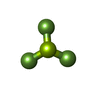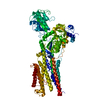+Search query
-Structure paper
| Title | Conserved N-terminal Regulation of the ACA8 Calcium Pump with Two Calmodulin Binding Sites. |
|---|---|
| Journal, issue, pages | J Mol Biol, Vol. 436, Issue 20, Page 168747, Year 2024 |
| Publish date | Oct 15, 2024 |
 Authors Authors | Sigrid Thirup Larsen / Josephine Karlsen Dannersø / Christine Juul Fælled Nielsen / Lisbeth Rosager Poulsen / Michael Palmgren / Poul Nissen /  |
| PubMed Abstract | The autoinhibited plasma membrane calcium ATPase ACA8 from A. thaliana has an N-terminal autoinhibitory domain. Binding of calcium-loaded calmodulin at two sites located at residues 42-62 and 74-96 ...The autoinhibited plasma membrane calcium ATPase ACA8 from A. thaliana has an N-terminal autoinhibitory domain. Binding of calcium-loaded calmodulin at two sites located at residues 42-62 and 74-96 relieves autoinhibition of ACA8 activity. Through activity studies and a yeast complementation assay we investigated wild-type (WT) and N-terminally truncated ACA8 constructs (Δ20, Δ30, Δ35, Δ37, Δ40, Δ74 and Δ100) to explore the role of conserved motifs in the N-terminal segment preceding the calmodulin binding sites. Furthermore, we purified WT, Δ20- and Δ100-ACA8, tested activity in vitro and performed structural studies of purified Δ20-ACA8 stabilized in a lipid nanodisc to explore the mechanism of autoinhibition. We show that an N-terminal segment between residues 20 and 35 including conserved Phe32, upstream of the calmodulin binding sites, is important for autoinhibition and the activation by calmodulin. Cryo-EM structure determination at 3.3 Å resolution of a beryllium fluoride inhibited E2 form, and at low resolution for an E1 state combined with AlphaFold prediction provide a model for autoinhibition, consistent with the mutational studies. |
 External links External links |  J Mol Biol / J Mol Biol /  PubMed:39168442 PubMed:39168442 |
| Methods | EM (single particle) |
| Resolution | 3.3 Å |
| Structure data | EMDB-18506, PDB-8qmp: |
| Chemicals |  ChemComp-MG:  ChemComp-BEF: |
| Source |
|
 Keywords Keywords | TRANSPORT PROTEIN / HYDROLASE Calcium transporter P-type ATPase / HYDROLASE |
 Movie
Movie Controller
Controller Structure viewers
Structure viewers About Yorodumi Papers
About Yorodumi Papers






